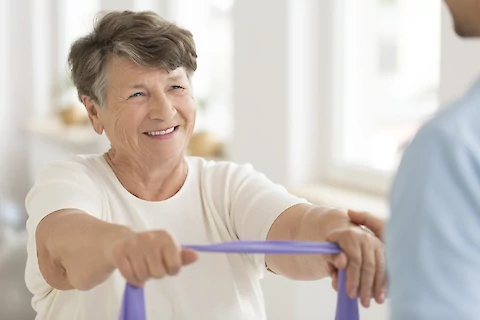
If you or a loved one is living with Parkinson's disease, you're probably aware of the importance of proactively managing the symptoms and effects of this condition. One effective way to do this is by incorporating physical therapy into your daily routine.
In this Senior Helpers of Cameron blog post, we will discuss the role of physical therapy in Parkinson's disease management and its benefits. Finding a therapist who can tailor a treatment plan to meet your individual needs can make a significant difference.
Benefits of Physical Therapy for Parkinson's Disease
- Improved mobility and balance: Physical therapy can help improve gait and balance, resulting in reduced falls and increased independence.
- Increased muscle strength and flexibility: Targeted exercises help maintain and improve muscle strength and flexibility, making daily activities easier and more manageable.
- Reduced stiffness and rigidity: Regular stretching and range of motion exercises can help alleviate muscle stiffness and rigidity, which are commonly associated with Parkinson's disease.
- Enhanced overall quality of life: By addressing the physical challenges that come with Parkinson's disease, individuals can experience a better quality of life overall.
Types of Physical Therapy for Parkinson's Disease
There are several types of physical therapy that individuals with Parkinson's disease can pursue. Here are some popular options:
- Traditional physical therapy: This involves a combination of range-of-motion exercises, strengthening exercises, and balance and coordination training to target Parkinson's disease-specific challenges.
- Specialized Parkinson's disease programs: Some physical therapists offer specialized programs focusing on Parkinson's disease. These include LSVT BIG and PWR! Moves, which use specific exercises and techniques to address the unique needs of individuals with the condition.
- Aquatic therapy: The buoyancy of water can provide support and resistance. It makes aquatic therapy suitable for individuals with Parkinson's disease looking to improve their strength and mobility.
- Yoga and tai chi: Incorporating gentle movement practices like yoga and tai chi into your routine can further enhance flexibility, balance, and relaxation, as well as improve core strength.
Tips for Finding a Good Physical Therapist
To ensure the best outcome from physical therapy, it's essential to find a therapist experienced in treating Parkinson's disease. Here are some tips to help you find a suitable physical therapist:
- Ask for recommendations: Talk to your healthcare team, support group members, or friends and family to gather recommendations on experienced physical therapists.
- Check for credentials: Ensure the physical therapist is licensed and credentialed to practice in your area.
- Schedule a consultation: Before committing to a therapist, schedule a consultation to discuss your individual needs and goals and assess if they are a good fit for you.
Creating a Tailored Treatment Plan
Once you've found the right physical therapist, they will work with you to create a tailored treatment plan that addresses your needs and goals. This process typically involves the following:
- Assessing your current physical abilities and limitations: Your therapist will conduct a thorough evaluation to determine your strengths and weaknesses.
- Setting realistic and achievable goals: Together, you and your therapist will establish goals to work towards throughout the therapy process.
- Developing a personalized exercise program: Based on your assessment and goals, your therapist will create a customized program designed to target your specific needs.
- Regularly reassessing progress and adjusting the plan as needed: As you progress through therapy, your therapist will reassess your goals and make any necessary adjustments to your treatment plan.
Importance of Being Proactive in Parkinson's Disease Management
Staying proactive in managing Parkinson's disease will significantly impact your day-to-day life. Here are some ways to achieve this:
- Regular exercise: Incorporate strengthening and flexibility exercises into your routine to maintain muscle health. Make sure you consult with your physician before starting any new exercise routine.
- Stretching: Reduce stiffness and rigidity through routine stretching exercises.
- Gentle activity: Engage in activities like swimming, walking, or dancing to improve overall well-being.
- Social activities and support groups: Stay connected with others who understand your experiences to foster a sense of community and support.
Senior Helpers Is Your Partner in Parkinson's Disease Management
If you or a loved one is living with Parkinson's disease in Cameron Park, Sacramento, El Dorado County, Shingle Springs, South Lake Tahoe, Plymouth, Sutter Creek, Sloughouse, Elk Grove, or Wilton, contact Senior Helpers Cameron Park in El Dorado County to learn more about how our services can help improve your quality of life.
Our expertly-trained caregivers are happy to assist seniors with personal care and everyday activities customized for the individual. Our in-home care services can give you and those you love the peace of mind you deserve.